Alicja Kwade’s mixed-media works manipulate mental perceptions and physical experiences of how the body inhabits space and time. Her common materials include items found in everyday life – coins, metal pipes, mirrors, glass, lights, and bicycles – that she then distorts to create sensory illusions. The results, sometimes slouching or stretching, can appear anthropomorphic. Alicja Kwade works in a large building – formerly a film studio- where we visited her last month.

Alicja Kwade’s Studio, Berlin 2015, photo Contemporary Lynx
DB: Art critics often emphasise the fact that your pieces tend to focus on three specific aspects: time, space and reality. This, however, is an oversimplification. Just as if we tried to place your work in a precisely specified spot on the map. How would you describe the place where your art belongs? What is the place you are in? Are you here and now? Do you prefer to stay in the past or dive into the future?
AK: The critics who write about my work often need to describe it in a certain way, so that everybody understands their message, which is why they use simple concepts and ideas. I am very critical of such an approach and cannot accept these simplistic analyses, especially when someone tends to emphasise the connection between myself or the topics of my works with “Alice in Wonderland”. The attempts to make such a comparison usually mark the end of our conversation. This may seem funny for the outsiders, but is not for me. Sometimes we can also read that I am interested in physics or science in general. This is the message critics try to put forward, but I am not able to make such a clear statement myself.
My interests focus on all the “paths” which lead us towards the question (or have this question as their starting point) of why the world is just the way it is. This is the oldest question in philosophy: why does the world exist, why is the Earth turning around, what are atoms… Why do we call a table a table if it usually is a piece of wood? Do we really exist the way we see ourselves or do we only think that we exist, but, in fact, our existence is mere illusion? Is the reality, which we believe to be experiencing, objective or subjective? Or, perhaps, we are under an illusion? These are the questions that I work on. However, I am not totally preoccupied with such “big” ideas. I also try to analyse more minor aspects, such as why this reality is as it is, and why something costs as much as it does and not more, or less. Who is creating the reality and how do we contribute to this process, namely how do we change the reality ourselves by means of our everyday activities and decisions? I think about these things all the time. Who is the “me”? Am “I” the same person today as “I” was ten days ago?
DB: So, are you “here” or already “there” and what does “there” mean for you?
AK: This is exactly why it is difficult for me to describe where I am precisely – whether it is the past or rather the present reality. This is actually very interesting for me. Let us go a little bit further – what is in between these two time zones? Is it possible to describe it and how can we do it? Where is the end and the beginning… People created the system, which includes common notions and ways to convey ideas. By this, I mean all the rules, divisions and measurements. This system is, however, something, which was imposed upon us by another person who was imperfect, fallible and mortal. We can say it is conventional in a way. But what is the true reality? This is precisely the sphere, which fascinates me.
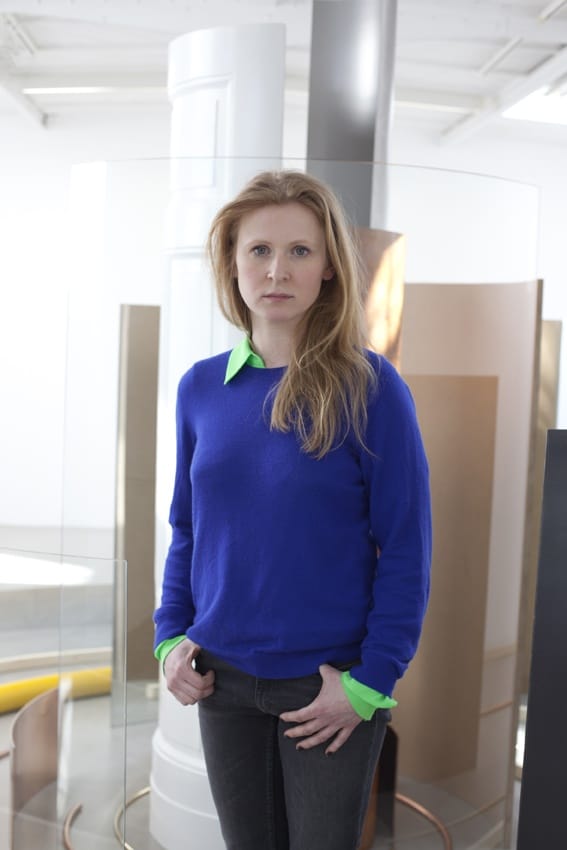
Alicja Kwade, photo. Fabrice Seixas, courtesy Alicja Kwade and KÖNIG GALERIE
DB: The system which we are now discussing and which you try to reinterpret in your works is not exclusively about measurements, geographical locations and time zones, but also about our commonly known spatial dimensions and the way they are related to objects around us, against which we try to define ourselves. Is that accurate?
AK: Yes, it is about dimensions through which we define such notions as reality and about the way we use them and invent them. The purpose of creating such dimensions is to make it possible for people to specify their position against the outside world and, thereby, define themselves. On the other hand, it is crucial to remember how easy it is to overturn and transform the existing systems, how relative they sometimes turn out to be, and how different is the way that people from various places or living in different periods use them. Out of all dimensions, time is the one, which is influenced by emotions to the greatest extent. Inventing and using dimensions is supposed to enable people to define themselves (describe their own physicality) and facilitate their common functioning and living in a group. These are really abstract spheres, which captivate our imagination and give us an opportunity to “devise” these intangible concepts or methods, which make our everyday life much easier. In the past, someone defined a minute as a minute and a second as a second, but this could as well have been changed and defined in another way (as can also happen in the future).
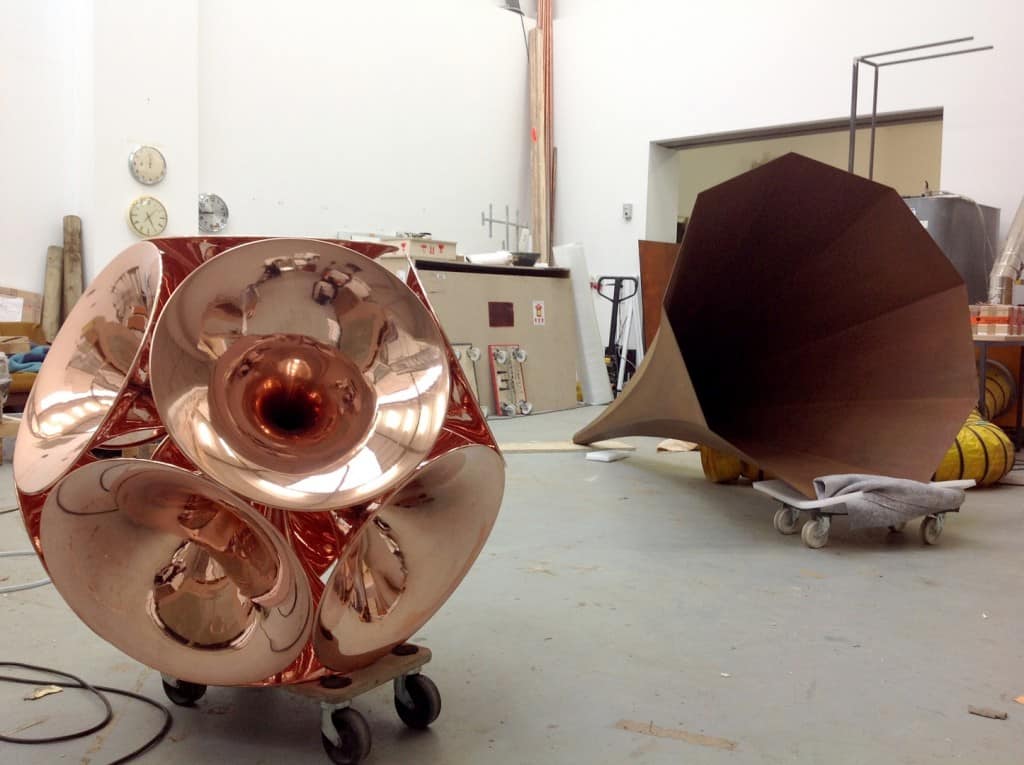
Alicja Kwade’s Studio, Berlin 2015, photo Contemporary Lynx

Alicja Kwade | ‘Der Tag ohne Gestern l – lll’, 2014-2015 Parcours in Basel 2015
© Art Basel
DB: In 2015, Boros Collection exhibited your work about the universe and sounds. Sound is another means, which allows you to create sculptures in space.
AK: Sound is the medium through which we can stir emotions in the easiest way. When we hear the clock ticking, we immediately know and feel that something is passing and a certain thing is measuring something. I also want to present sounds, which exist around us but which we cannot hear. These sounds are outside of our presence – our body is not able to perceive them. Such was, for example, the case with my work exhibited by Boros. The sounds which I present and make people aware of, have always existed in that building and are still around us. My task is merely to arrange space in which, until the present moment, this specific aspect has not been brought to light..
In general, in my works I try to present sound which has actually already been in that given venue, and constitutes an integral part of them, but has remained indiscernible so far. Sound is nothing alien or external to my works. This shows how narrow the part of reality which we are able to perceive and experience is.
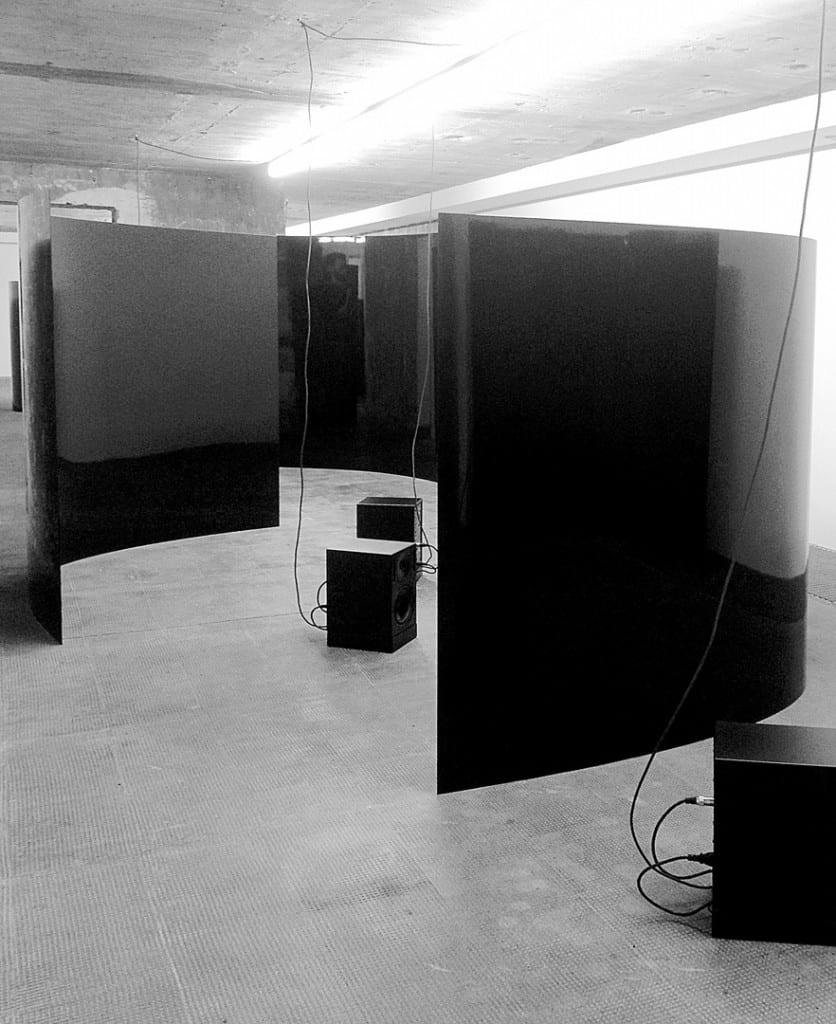
Alicja Kwade, Boros Collection, Berlin, photo Contemporary Lynx
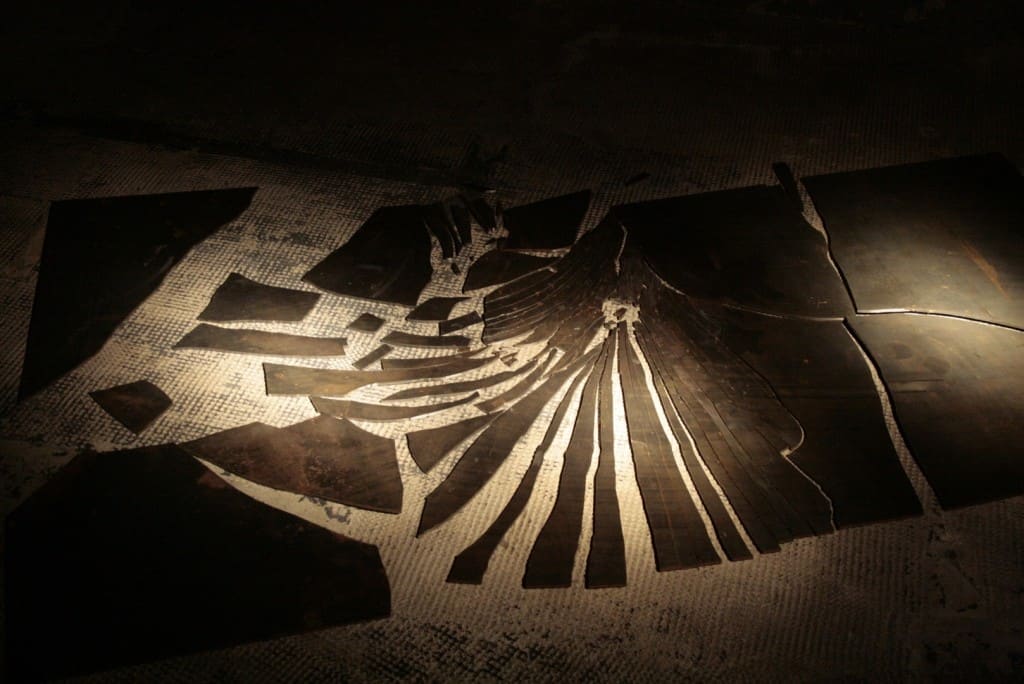
Alicja Kwade, Boros Collection, Berlin, photo Contemporary Lynx
DB: And we have a really limited number of instruments to guide our perception…
AK: We do indeed and this is why we are constantly developing, looking for methods to learn something more about ourselves. Nevertheless, there are physical obstacles…
This is how we came back to the question we discussed at the beginning of our conversation, namely my willingness to integrate the “eternal” issues with the aspects experienced by every person.
Scientists claim that everything originated in the universe at the moment of the Big Bang. This theory was formulated as a result of continuous research and its subsequent conclusions. Yet, there is nobody who has seen it with his or her own eyes. This theory and model, which describes the creation and evolution of the world, are currently assumed the most likely scenario. But, the most likely does not mean that what happened was exactly the way scientists describe…
My interests focus on the way we use this abstraction in real life. I look at how we “devise” time, dimensions, but also what is the basis of our assumptions on how it could have been. Since we do not know any form outside of our universe, these are all presuppositions based on hypotheses. In fact, the very idea of defining the universe as a form is abstract.
DB: For thousands of years people have been trying to understand the unknown and become accustomed to it, which is why they try to measure it by means known to humans and use well-known notions to describe it. On the one hand, this reflects our desire to shorten the distance, on the other hand, it is a proof of our effort to familiarize ourselves with things we are horrified and overwhelmed by (the function similar to ancient mythology).
AK: Because we are mere dust, or animals with limited abilities. Our abilities are our limit. We have to accept this fact. Here is where, for example, religion comes into our lives, because it allows us to explain the unknown and unfamiliar. There is also philosophy and physics, which, by taking small steps, try to investigate the unknown reality. There is a single goal of all these disciplines, namely to explain why the world looks just as it does and not in any different way.
DB: And what about art? What is its role?
AK: Art asks questions which it is supposed to answer itself. It is a kind of philosophy, reduced to its physical aspects. However, it not always is so. Art is a question and an attempt to answer it. Art is not always understandable and not always succeeds in giving answers or even suggesting them. In fact, it is sometimes nothing more than an object. Certain spot along the way. Art is something in between philosophy and psychology, since it is related to human emotions, which I have already mentioned.
DB: At which point do you feel your work is finished? Or perhaps it is a continuous process?
AK: I perceive my work as a constant development process. Obviously, sometimes I treat a series of works as a finished one, which means that I reached a point from which I am not able to continue creating works in a certain convention, or that I managed to achieve the effect I strived for, so this is the end. Usually, however, one work is a starting point for another one. One work gives rise to another one, since I am learning while creating. Thanks to this, I hope, each time I manage to formulate the questions, which bother me, in a better way. Everything revolves around a certain axis. This is a pleasant surprise for me. About ten years ago, I used to create my works instinctively, going from one work to another. But now, when I present objects from different periods during a single exhibition, I notice that it all makes sense, since the works are all mutually connected.
DB: You create objects and spatial installations. Most of your early works consisted of isolated objects, which independently expressed the intended message. However, for some time now your works have been going beyond objects and have engaged the audience. What is the role of the audience in your creative process and has your attitude towards the audience and their involvement changed as well?
AK: Indeed, my attitude changes as much as my creative abilities. I always try to think about my audience and possible different ways in which they perceive the picture or installation, as well as how they influence it as a whole. What I strive for is that my exhibitions tell certain stories. I try to reduce the number of isolated objects. Objects are supposed to influence a person and lead him or her through subsequent scenes, which merge into a story or deliberations I want to present to him. I understand that someone looking around the exhibition is going to remember only certain elements and forget about the other ones. This is exactly what I try to use – people’s limited perception. As I work on new installations and prepare new exhibitions, the key factor for me is my awareness that only certain pictures will remain imprinted on our memory – some of these pictures function as déjà vu, and come back to us later. I wonder how my audience feels while confronted with this phenomenon, what they can notice and what they are unable to see. I also think about what they are going to take for themselves: what picture and emotions. I would like to create an atmosphere, which is unreal for my audience – or rather, one that belongs to a different world, the one that people enter through my exhibition.
DB: Which is why you present things, which your audience is unable to notice in normal conditions, without your “intervention”, just as you did at Boros gallery…
AK: This is true. In my creative activities, I try to use déjà vu phenomenon more and more often. I separate my works. For example, when certain work consist of two objects, I places these two objects in separate rooms. One can understand or create the whole picture only after seeing the entire exhibition and combining all the necessary pieces, applying more or less holistic approach.

Die gesamtheit aller Orte, 2012. Courtesy Alicja Kwade and KÖNIG GALERIE. Photo: Roman März
DB: A motive/sensation of déjà vu, coming back, memory is present in many of your works. The example which comes to my mind are centralizing installations (like for example ‘Die Gesamtheit aller Orte’), where everything is “spinning around” and as we change our position against the installation, we see more and more elements which appear similar. We do not know where everything starts and finishes. Your clocks turn, their hands move, but is it all happening in the reverse direction? The starting point and the finish faded away because the time reversed, but subsequently feels the same.
AK: It is so, indeed. For example, it is difficult to remember a form after being exposed to it for less than 30 seconds, unless this form is a red square… I try to make use of the weaknesses and limitations of our senses.
DB: Let us now talk about the loop… At your first individual exhibition in Poland, which is presented at Trafostacja Sztuki in Szczecin, you decided to show your earlier videos. This means that looping is not only about your works, the narration of your exhibitions, but it also directly affects your life.
AK: At my Szczecin exhibition, I am showing a huge installation, which I presented in Berlin in 2013. This installation creates a different impression in every room where it is presented. It is one of my most prominent works, which was widely reviewed. The space I work in and the possibilities it offers are very often closely related to the way I work and the end results. This is exactly how I came up with the idea to present my very early videos in the space I had available in Szczecin, which consisted of small, cosy rooms. These videos were created really early in my career, so their quality is not very high. Nonetheless, even I was curious to see how they will look in small rooms, instead of huge auditoriums. It was even more interesting, since these videos are drafts, which evolved into a great number of works and this whole process brought me to the present moment. Despite a youthful attitude, which prevails in those videos, many issues I am now presenting in my works were also tackled there. I have not realised this fact earlier. I think that five years ago I would not have been so willing to show these early works to the public.

Alicja Kwade’s Studio, Kaiser Idell lamp, Berlin 2015, photo Contemporary Lynx

Alicja Kwade, Boros Collection, Berlin, photo Contemporary Lynx
DB: Drawing inspiration from the past, which earlier in our conversation you have described as treating the early works as a basis for creating the new ones or as a thought which is omnipresent and links various stages of your artistic activity, is, in my opinion, visible in yet another way. You create your works from found objects, which have their own history. You act a bit like a collector of artefacts and the past. I read that you look for such items at antique fairs or on eBay. Is the history of these objects important for you or do you treat them as mere form?
AK: I would not want to generalise, but people living in our times, in a place where they share a common culture, for example in Central Europe, understand and recognise the same set of symbols. The objects I use are commonly recognised, their symbolic meaning or history, as well as all nuances are also easily understood in our culture. Therefore, I can expect that they evoke certain reactions or emotions. I often use Kaiser Idell lamps, which were popular in the 1930s. These lamps feature in every movie from this period, while from 1935 to 1939 they were used in the majority of German offices. Their history is really specific – it is linked with the history of art, as well as the events, which took place in Europe during these years. What is more, the lamps mean light. This model is one of the most widely recognised Bauhaus lamps. When I select these objects, I do not try to undermine the multiple factors, which give them their meanings. In fact, I try to combine this variety of meanings. The time when something was created is really important. For example, in case of certain things you know immediately that they were produced in the 20s or 50s. Thus, when I take over these objects, I simultaneously take over the history of that period, of which they are a part.
DB: This is a really interesting combination and the next point along this chain of connections, memory loops, meanings and characteristics. I also heard that the place we are currently in, namely your studio, hosted film studios where Marlene Dietrich movies were shot.
AK: This was in the early 20s. These were the headquarters of UFO FilmStudios. “The Blue Angel” was shot here. In this studio, there was a dressing room and a cashier’s office, where artist were paid their daily salaries.
With these objects, I always strive to find possibly the simplest form. I look for the form strictly connected with the function. Therefore, I use clocks and lamps with very simple shapes. I try to reduce the significance of their appearance and emphasize their intended use.
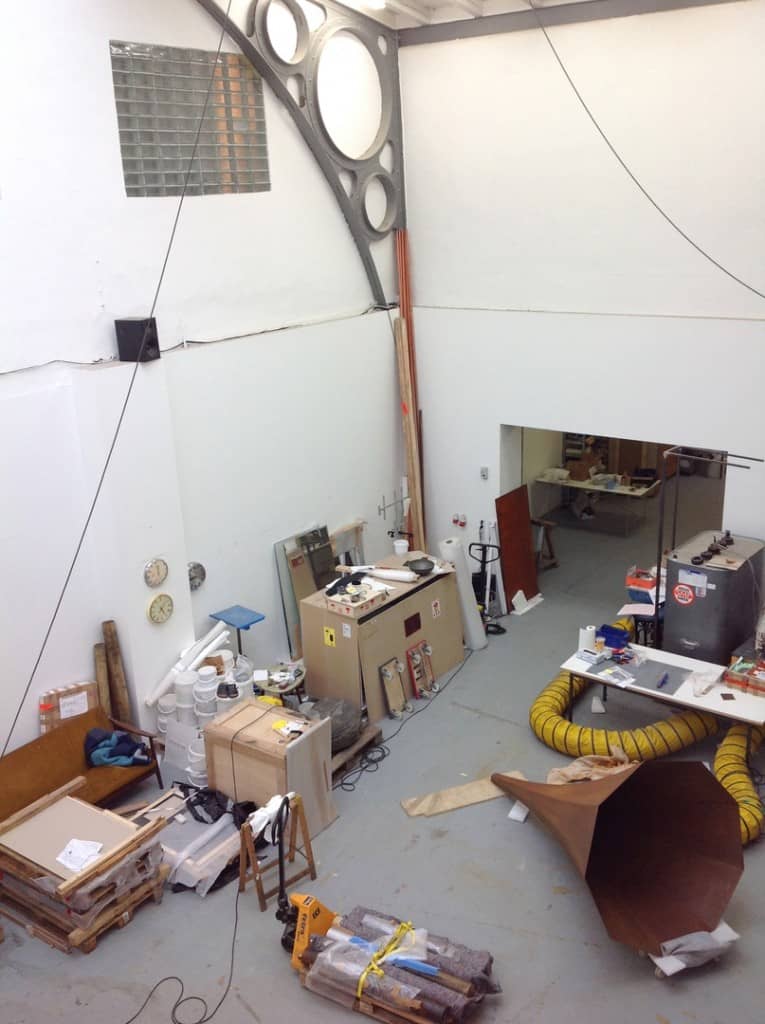
Alicja Kwade’s Studio, Berlin 2015, photo Contemporary Lynx

Alicja Kwade’s Studio, Berlin 2015, photo Contemporary Lynx
DB: So you strive for minimalism of the form and content.
AK: Exactly.
DB: I would say, your works are slightly post-minimalist, at least in formal terms.
AK: Of course, we can say that I use the language of minimalism, but the focus of minimalism was on form rather than on history. I try to reduce form to the minimum, so that the focus is on content.
DB: What is your work like? Do you prepare drafts at the very beginning and already know the final result of your work when you start the creative process? Or maybe your works evolve during this process?
AK: The process is different every time, but the changes I introduce at a later stage are usually minor, due to practical issues. If works are really big and complicated, at the first stage of the process every element must be described in detail. Only after that, this element can be produced. Everything is measured with millimetre accuracy. I make bigger and bigger models, sometimes even on a 1:1 scale. When the design goes into the production phase, it is already too late to change anything. This is really difficult. You can prepare many designs and drafts, but the exact final result is sometimes difficult to predict. When it comes to smaller works, which I can create in my studio, they obviously change as the creative process goes on. I can modify these works and I face fewer limitations.
DB: So for you the idea is more important than form.
AK: Absolutely. Before I make my plans a reality, I read a lot and gather new information. When I draft something, I already know what it will look like and what material it will be made of – I have never changed such decisions at a later stage. Of course, certain details need to be changed when you have the physical form, but apart from minor details, my works are fully defined at the draft stage. When I make a sculpture of copper, I select this material not only for aesthetic reasons, but also because of its properties, e.g. electrical conductivity, oxidation, the whole symbolism…
DB: Where do you look for inspiration?
AK: I read a lot, but I do not finish books. When I browse through books and read I get fascinated with certain ideas and start my own research. I also use my own analyses and images I create on the basis of what I read. Then I sit down and start drawing, looking for the proper form. Sometimes it is a very long process before I am able to draw the appropriate form. Once it took me two years.
DB: I heard that the objects that you find stay in your studio for several years before you use them.
AK: It is often a long process before these elements and ideas are properly combined. In one of my series, I focus on the lines dividing time zones. These works are about the history and idea of such division, about how this division was created and its authoritarianism. I did not know how to present these topics for a really long time. I tried out various methods. It took a long time to make a final decision.

Alicja Kwade’s Studio, Berlin 2015, photo Contemporary Lynx
DB: So we came back to the question of limits and defined dimensions, which were imposed on us. Some time ago, you said that, according to some theory, there are 11 space-time dimensions, which exist simultaneously.
AK: Indeed, this is an opinion of some researchers. This idea is interesting for me. This theory is necessary so that the string theory could be deemed coherent. The latter is the theory, which explains how everything works. The idea is attractive for me as a person. In fact, what do the words “me” and “you” mean? Every single decision, which I make today, will lead me in a different direction than it could have developed. Who knows, maybe this decision develops somewhere else at the same time… At any moment, we are in the middle of all the possibilities of our life. We are always multipliers of our beings. Different decisions lead us onto different paths, but this multiway development potential exists in every moment of our lives.
Who determines that there are only three dimensions? We do not know other dimensions of our existence or we have not been able to get familiar with them yet. But maybe we develop in these eleven dimensions simultaneously?
DB: I remember one of your works – the mirror with a copper arrow attached, which started concentric waves at the place it touched the mirror, thus creating an impression that we were looking at the entrance into another dimension…
AK: This is a moment of collision. A mirror is a symbolic object, which defines reality or unreality, reflects, creates pictures and worlds inside. In this sense, it is a very active artefact. On the other hand, it is also passive – it merely casts light.
DB: Art is about similar things: sometimes it connects opposite realities, creates them, and sometimes it just reflects our reality; it is active and passive at the same time…
Thank you for the interview.

Alicja Kwade’s Studio, Berlin 2015, photo Contemporary Lynx

Alicja Kwade, Boros Collection, Berlin, photo Contemporary Lynx








